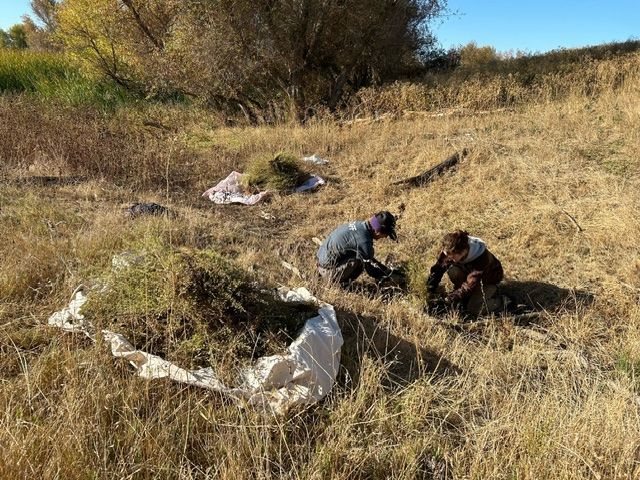Science Corner - Non-native Species, Friend or Foe

Admittedly European Starlings (Sturnus vulgaris) are pretty cool birds. They are relatively intelligent for possessing a bird brain and can vocally mimic over twenty different bird species including American Robin, Killdeer, Red-tailed hawk, Northern Flicker and Western Meadowlark just to name a few local birds. They can fly at nearly 50 miles giving us those fascinating aerial displays called murmurations and have been wildly successful at crowding out native bird species. You may have heard that they were released into New York’s Central Park in the 1890’s but they were also released in several other states including Ohio, Oregon, Pennsylvania, Massachusetts and even Quebec, Canada. It appears to have been the few dozen birds released in Central Park that eventually became successful and today there are an estimated 200 million breeding adult European Starlings in North America - all believed to be descendents of the original few. European Starlings (starlings) are responsible for causing billions of dollars annually to fruit crops such as apples, cherries, figs, grapes, peaches and strawberries as well as transmitting bacterial, fungal and viral pathogens and parasites to livestock as well as decimating their feed. Gathering and roosting in huge flocks, their droppings soil buildings, windows, sidewalks and anything else that happens to be in the way. It can corrode metal if not cleaned off promptly and also can transmit Salmonella and E.coli causing a public health hazard.
Introducing plants and wildlife into a region where they have no natural predators makes their establishment uncomplicated, unchallenged and almost effortless. Just a few other non-native species that became introduced over a short period of time include vegetation such as Japanese knotweed, a dense, rapidly growing plant that crowds out native species and damages drainage systems and buildings by growing through cracks. The list also includes bacteria, fungi and viruses such as West Nile virus and Bird flu (both of these are an ongoing battle), Small Pox (we all know what that did) and Dutch Elm disease, a fungus that killed a majority of the Elm trees in North America in just two short decades. Aggressive insects that have been introduced include the Formosan termite that causes over one billion dollars in damages annually to US homeowners and Murder Hornets, the two inch long jerk that can decimate a honey bee colony in less than two hours (thankfully it is believed that they have been eradicated). The invasive sea lamprey has very nearly wiped out the entire lake trout fishing industry in the Great Lakes. Giant Asian Carp and the Burmese Python have both caused a huge ruckus and extensive environmental damage while ship rats have provided us with both the plague and typhus. Currently here in our region we are fighting a battle with Zebra Mussels, desperately trying to keep them out of waterways where they have not been observed by cleaning and quarantining water craft and equipment.
Globally, invasive species cause over $400 billion in damages annually, most of them occurring in the agricultural industry with an estimated $150 billion in losses here in the United States. Add to that the billions of dollars spent aimed at keeping additional invasive species out of the United States by agencies such as the United States Environmental Protection Agency (EPA), the United States Department of Agriculture (USDA) and The Bureau of Land Management (BLM).
Laws have been passed aimed at making it illegal to knowingly import injurious species into the US but some argue that we could be doing more. Island nations such as Australia and New Zealand ban plants and animals unless they appear on an “approved” list while the United States allows them in unless they are on the “banned” list.
It’s not all dismal though. There have been some benefits to introducing non-native species. In 1898 the USDA created an agency called the Office of Plant Introduction that was responsible for collecting, introducing and distributing economically valuable plants and seeds from around the world. The agency ultimately imported over 200,000 useful species of plants to the US and was instrumental in industrializing our agriculture industry. Some of these plants have become major agricultural staples in California and the rest of the United States including fruits and vegetables such as artichokes, avocados, carob, chayote, citrus fruits, dates, lychee, mangos and papaya. Hard red wheat and durum wheat was also brought into the US from Russia and the Ukraine and have become significant grain crops in the US. And, all know the importance of California’s rice industry!
For the record, I have to confess that I don’t hate starlings (but as a biologist maybe I should?). I think their murmurations are enchanting. I think it’s intriguing that they go from having white speckles to being a solid, glossy iridescent dark brown without shedding their feathers (the speckles are white tipped feathers that get worn as the season goes on leaving them a solid dark color). And I think that their charismatic vocal abilities are incredibly charming.
RECENT ARTICLES






